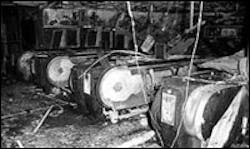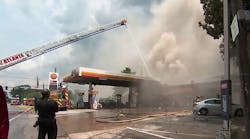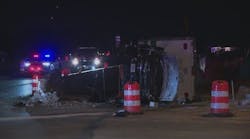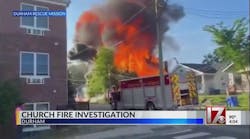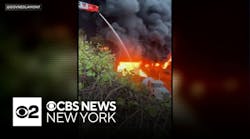At approximately 19:32 Hours on Wednesday 18th of November 1987, passengers coming up the Piccadilly line escalator noticed a small fire showing through the wooden steps of the escalator about 20 ft or so from the top.
After being alerted to the Fire by Passengers The first call to the London Fire Brigade was received at 19:36 Hours from Station staff. As if by a wicked turn of fate the Local Station A23 Euston that was just half a mile along the same road were out on a Fire Call elsewhere, subsequently Appliances from C27 Clerkenwell, A24 Soho and A22 Manchester Square were ordered onto this incident.
The Crews from Clerkenwell and Soho fought there way through the dense London traffic arriving at 19:42 Hours. The most senior Officer at the scene was Station Officer Colin Townsley from Soho. Townsley and a crew went to the concourse of the Station where they were directed to the Piccadilly line escalator. By this time, the flames had reached about 4 foot in height. Townsley ordered his Crew back to the surface to fetch a Hoseline and get more Crews into SCBA. The Leading Fireman from Clerkenwell was detailed to send a 'Make Pumps Four' Assistance Message to Control.
The Officer in charge of Clerkenwell's Pump had descended one of the adjacent escalators to stop members of the Public; who were still at this point going about there business as if nothing was happening. The remainder of the Clerkenwell Crew rigged in SCBA passed the Soho Crew who were going to fetch the hoseline.
The time was now 19:45; Station Officer Townsley had now been joined by Station Officer Osborne from Manchester Square, hearing a commotion at the top of the escalator, Osborne moved that way, noticing dense smoke and flame at ceiling level. He descended the Victoria Line escalator to prevent more people from coming up to the concourse. Almost instantaneously there was a very rapid build up in heat and smoke, the area was plunged into darkness and temperatures became unbearable.
The remaining Firefighters who had returned to the Street to help collect hose were met with thick Black Smoke suddenly exploding from all of the Entrances to the Station a large number of screaming burned passengers exited to the street.
Station Officer Townsley was guiding passengers from the Station and was last seen helping a woman to the exit when the fireball erupted.
The SCBA Crews, armed with a Powerful 2 &1/2 inch Jet tried to enter the Station, they compared the experience to 'entering a volcano' Progress was slow and torturous with Crews fighting the fire being cooled by other Firefighters.
Assistant Divisional Officer (ADO) Shore arrived amid chaos at 19:49; finding No incident Commander he sent a further Assistance Message requesting More resources.
The Crews from Soho had managed to make a little progress with the protection of another hoseline; they came across Station Officer Townsley and removed him to street level. Sadly efforts to resuscitate him were in vain.
By 2015 Deputy Assistant Chief Officer (DACO) Wilson was in attendance and in charge of the incident. He had been informed that several Firefighters were missing and a roll call was being carried out. Faced with what was fast becoming a disastrous incident with bodies being discovered by the minute by Crews still battling the inferno Wilson sent a 'Make Pumps Twenty Message'. He was further informed that 3 Firefighters (including Stn O Townsley) had been removed to University College Hospital. Unknown to him, Station Officer Osborne from Manchester Square and Sub O Bell from Clerkenwell were still below the fire, all trains were ordered to by pass the Station once the remaining passengers were evacuated from the platforms.
The Incident was ultimately commanded by the legendary Assistant Chief Officer 'Joe' Kennedy, Commander for the Eastern area of London and the Brigades 'third' Officer. The Incident reached 30 Pumps before being brought under control late in the night.
The 'Stop' (under Control) message read;
From ACO KennedyStop for Kings Cross Underground Station
The whole of a circular main concourse 50 Metres in Diameter serving 4 Underground lines and 1 British Rail line, 2 pedestrian tunnels from street to concourse to platform level 100% Damaged by Fire.
3 Jets, Breathing Apparatus
Unknown number of Persons rescued by Brigade from Concourse and platforms
23 Persons injured
34 Persons apparently dead
All Persons not yet accounted for
Same as all calls
The Brigade remained on the scene until the following evening.
A week and a half later, Thousands of UK Firefighters took to the streets of Central London to line the route (that passed Kings Cross) for the Funeral of Station Officer Townsley.
6 Firefighters were awarded the Chief Officers Commendation including Station Officer Townsley who received the award posthumously; fourteen further Firefighters received letters of Congratulation for their Bravery.
Following the Fire, one of the biggest enquiries ever seen in the UK was undertaken, lasting 91 Days the enquiry heavily criticised London Underground for the lack of maintenance and cleaning on its escalators. Ignoring advice following another fire at Oxford Circus in 1984 they did not fit sprinklers. The fire was believed started by smoking material dropped onto the escalator that then rolled into the edge, starting the fire.
The enquiry also uncovered a previously unknown type of Fire Growth the Trench effect. The Following passage is taken from Firetactics.com Paul Grimwood was part of the Official LFB Investigation team;
"This trench effect was seen to cause hot gases in the buoyant plume to lie along the escalator surface and create a rapid airflow which caused these gases to curl over and over towards the next steps above. The airflow in the Trench increased in proportion to the size of the fire, eventually creating a flamethrower type effect up and into the ticketing Hall"
Beyond Doubt at the enquiry was the Bravery and commitment of the London Fire Crews who attended the incident that night. LFB brought forward its new Fire Kit project that was being trialled in 1987. At the time of the fire, London's Firefighters were still issued with heavy double breasted woollen fire Tunics, Yellow waterproof leggings and rubber gloves. In many cases the rubber gloves melted onto the facemasks of the SCBA sets as Firefighters attempted to clear their facemasks of debris.
